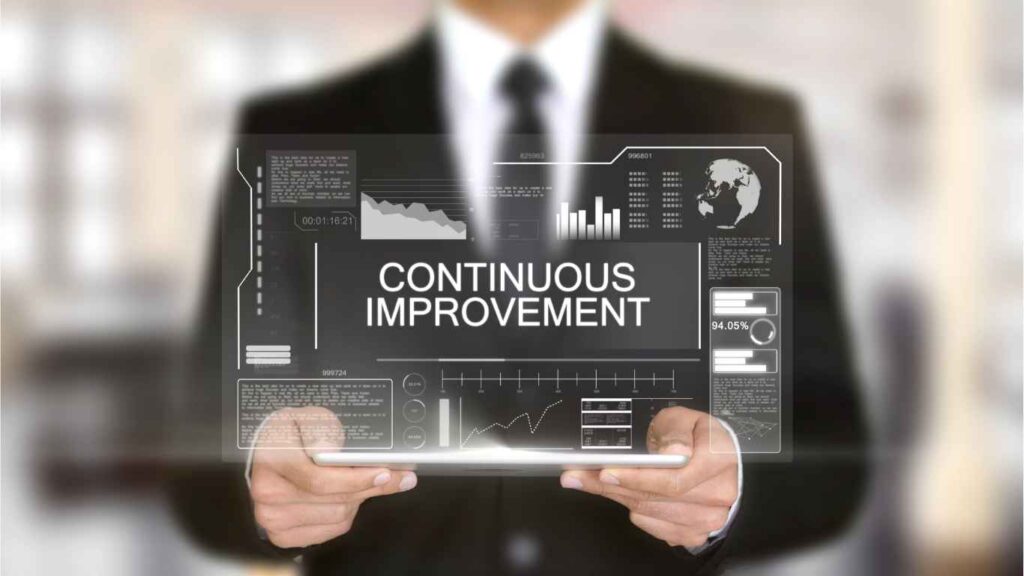Agile product lifecycle management has become a crucial aspect of running a successful business in today’s fast-paced market. With constantly evolving customer needs and technological advancements, companies must adapt and streamline their product development processes to stay ahead of the competition. This is where agile product lifecycle management comes in – a methodology that focuses on flexibility, collaboration, and continuous improvement.
In this blog post, we will discuss five essential tips for implementing agile product lifecycle management in your business, to help you achieve efficient and effective product development.
Tabel Of Content
- Understand the Philosophy of Agile PLM
- Prioritize Customer Collaboration Over Contract Negotiation
- Foster a Culture of Continuous Improvement
- Use Agile Tools for Better Product Management
- Invest in Agile Training and Skill Development
Understand the Philosophy of Agile PLM

Immersing yourself in the philosophy of Agile PLM is your first step to effective implementation. It’s more than a systematic approach; it’s a comprehensive mindset that is grounded in collaboration, customer satisfaction, and the nimbleness to adapt to swift market changes. The emphasis here is on progressive development and constant feedback, which are vital for producing early and frequent functional versions of your product.
Agile PLM isn’t about rigid structures or procedures, but it’s a framework that thrives on flexibility and adaptability. This philosophy enables teams to pivot and alter direction in response to new information or changing customer requirements, thereby facilitating the creation of products that align with market demands.
Underpinning the Agile PLM philosophy is the core value of human interaction. It fosters a conducive environment that encourages teams to work together, to communicate more openly, and to break down any existing silos. This people-first mentality leads to more innovative ideas, improved problem-solving, and a more cohesive product development strategy.
Understanding the Agile PLM philosophy isn’t merely an academic exercise; it’s about embracing a new way of thinking and working. This understanding will be instrumental in effectively incorporating Agile PLM into your business operations, and leveraging it to enhance product development and customer satisfaction.
So, delve deep into the Agile mindset, understand its principles, and see how it can be a game changer for your product lifecycle management.
Prioritize Customer Collaboration Over Contract Negotiation
At the heart of Agile PLM is the concept of customer collaboration, which takes precedence over the traditional contract negotiation. While contracts are indeed crucial to outline the scope of the project, Agile PLM introduces a refreshing perspective that recognizes the dynamic nature of customer needs throughout the product lifecycle.
It’s all about openness and flexibility when customer requirements evolve, allowing your business to develop solutions that stay relevant and effective. Frequent and meaningful interactions with customers are an integral part of Agile PLM. These interactions are far more valuable than simply sticking to a rigid contract.
They provide insight into the customer’s changing needs and expectations, and give you the ability to pivot your product development accordingly. This customer-centric approach is what makes Agile PLM so responsive and efficient. In Agile PLM, the contract isn’t the final word. Instead, it serves as a flexible guide that can be revised and refined in response to ongoing customer feedback.
This ongoing collaboration between you and your customers ensures that the end product is one that truly meets their needs, surpassing their expectations, and delivering optimal value. In essence, Agile PLM calls for a paradigm shift from contract-focused to customer-focused product lifecycle management.
It’s a journey of frequent check-ins, active listening, and swift adaptations that lead to products that resonate with the current market demands. Prioritizing customer collaboration in this way keeps your finger on the pulse of your customer’s needs, paving the way for a product that is well-received and successful.
Foster a Culture of Continuous Improvement

Promoting an environment of continuous improvement is a cornerstone of Agile PLM. This approach not only enhances the overall quality of your products, but it also increases efficiency across the board. By establishing a culture that embraces the idea of ‘always improving’, you set the stage for constant evolution, where every process, every team dynamic, and every product is subject to review and refinement.
In Agile PLM, continuous improvement isn’t just a nice-to-have, it’s a need-to-have. It’s not about sticking with what works but about seeking ways to make it work even better. It encourages the team to challenge the status quo and to always look for opportunities to do things better, faster, and more efficiently. This culture of continuous improvement serves as a catalyst for innovation and creativity.
To make this culture a reality, encourage your team to embrace the principle of ‘inspect and adapt’. Regularly evaluate your workflows, practices, and team dynamics to identify any areas that could benefit from change or enhancement. Use retrospectives or review meetings as a platform for open discussions where team members can voice their thoughts, observations, and suggestions for improvement.
These discussions should not only be focused on what needs improvement, but also on what is working well so that successful practices can be reinforced and replicated. On top of that, Agile PLM insists on viewing failures or setbacks as learning opportunities. It’s about fostering a blame-free environment where mistakes are seen as chances to learn and grow.
When your team is free from the fear of failure, they are more likely to take calculated risks and push boundaries, ultimately leading to better products and processes. In the Agile world, there’s no finish line when it comes to improvement. It’s an ongoing journey where you keep pushing the envelope, refining your processes, and setting new benchmarks.
By fostering this culture of continuous improvement, you prime your team for excellence, pushing them to reach their full potential and beyond. Ultimately, this leads to products that are of superior quality, and a product development process that is efficient, nimble, and in step with the dynamic business landscape.
Remember, the heart of Agile PLM beats with the rhythm of ‘continuous’. So, let this spirit of continuous improvement permeate your organization, encouraging every individual and every team to aim for the stars while keeping their feet firmly grounded in reality. This balance between ambition and pragmatism will be key to your Agile PLM success.
Use Agile Tools for Better Product Management
Stepping up your Agile product lifecycle management is as simple as integrating Agile-specific tools into your workflow. These powerful resources provide the scaffolding to organize, plan, and manage your projects more efficiently. From enabling seamless collaboration to simplifying backlog organization and sprint planning, Agile tools are designed to drive productivity and streamline your PLM processes.
In the Agile landscape, project management platforms take center stage. These digital workspaces become your team’s command center, offering features to coordinate tasks, track progress, and facilitate real-time communication. Agile tools allow for a bird’s eye view of your project, keeping everyone on the same page and in sync with the progress and changes.
They foster transparency and accountability, making it easier to identify roadblocks, manage resources, and stay ahead of deadlines. But the functionality of Agile tools goes beyond project management. They also provide comprehensive solutions for backlog management and sprint planning. With visual interfaces and intuitive controls, you can easily organize your product backlog, prioritize tasks, and plan sprints efficiently.
These features empower you to stay in control of your product development, ensuring that the most critical tasks are always front and center. Another appealing aspect of Agile tools is their ability to track and manage changes. Given that Agile PLM is characterized by its responsiveness to change, having tools that can seamlessly accommodate and track these changes is invaluable.
From modifying tasks and timelines to adjusting priorities, Agile tools make it easier to stay agile in the truest sense. Let’s not forget about the analytical capabilities of Agile tools. With their built-in analytics, you can gauge your team’s performance, identify trends, and make data-driven decisions. Whether it’s tracking the velocity of your team, measuring the burndown rate, or analyzing the completion time of tasks, these insights enable you to optimize your processes and improve efficiency.
To sum up, Agile tools are the workhorses of Agile PLM. They provide the framework, the organization, and the insights necessary for efficient and effective product lifecycle management. So, as you embark on your Agile PLM journey, don’t overlook the power of Agile tools. Harness their potential and see how they can transform your product development process, making it more structured, productive, and adaptive.
Invest in Agile Training and Skill Development

Effective implementation of Agile PLM demands more than just a theoretical understanding of its principles. It requires a team equipped with specialized skills and a firm grasp of Agile methodologies. Therefore, a crucial step towards successful Agile PLM is investing in comprehensive training and skill development for your team.
The beauty of Agile is in its simplicity, but don’t let that fool you. Adopting an Agile mindset and successfully applying its principles to your product lifecycle management requires proficiency in Agile techniques. Hence, providing your team with robust training can pave the way for a smooth Agile PLM execution.
From understanding Agile philosophies to mastering the use of Agile tools, this training will arm your team with the necessary knowledge and skills. But the benefits of Agile training extend beyond skill acquisition. It’s a strategic move that fosters an Agile-friendly culture within your organization.
With everyone well-versed in Agile methods, you’re creating an environment conducive to Agile PLM. A well-trained team is more likely to embrace the Agile mindset, be open to continuous improvement, and be responsive to change – all hallmarks of an Agile culture. It’s also worth mentioning that Agile training isn’t a one-off event but a continuous process. Agile methodologies evolve, and to stay current, your team needs ongoing training.
This continual learning approach aligns perfectly with the ethos of Agile – it’s all about constant growth and improvement. Don’t forget to diversify the training to cover all aspects of Agile PLM. From project management and backlog organization to customer collaboration and feedback integration, ensure your team has a well-rounded Agile education. Remember, a team that excels in Agile is a team that excels in product lifecycle management.
Also, consider investing in Agile certifications for your team. These not only validate their Agile knowledge and skills but also boost their confidence in applying Agile methodologies. Plus, they add credibility to your business in the eyes of clients, investors, and partners.
In a nutshell, Agile training and skill development is a key ingredient in the recipe for Agile PLM success. It’s a worthwhile investment that builds a competent team, promotes an Agile culture, and ultimately enhances your product lifecycle management. Take this step towards Agile mastery, and watch your business thrive in the dynamic and competitive world of product development.



